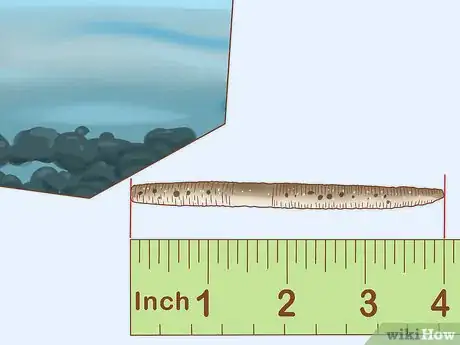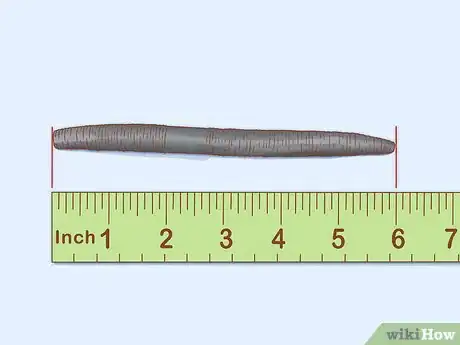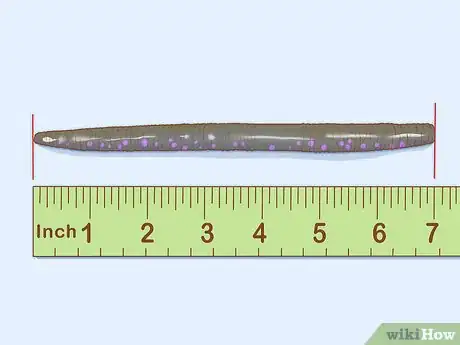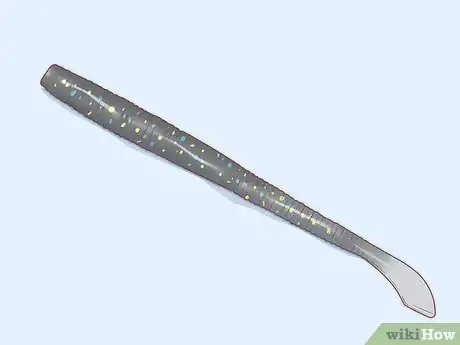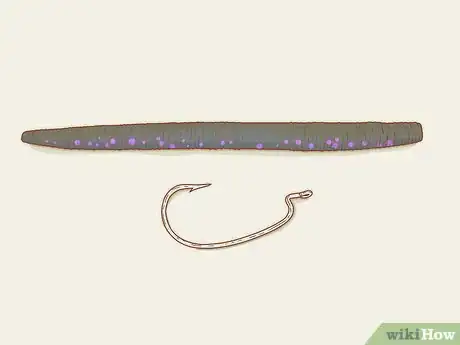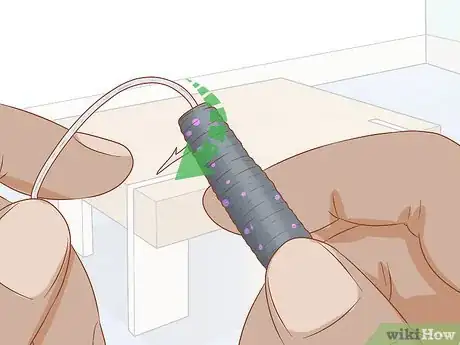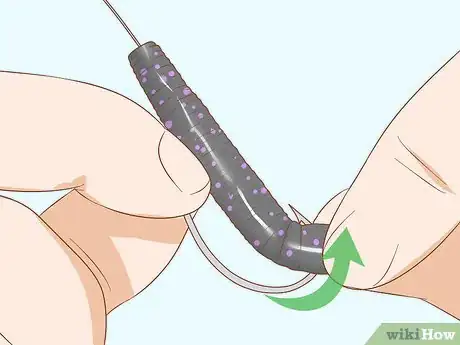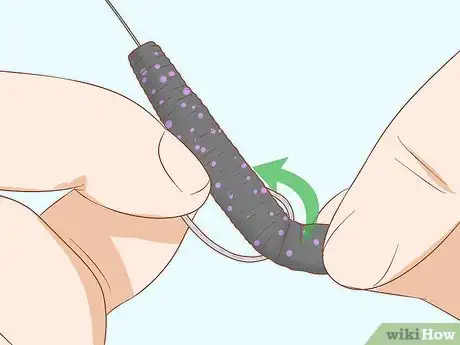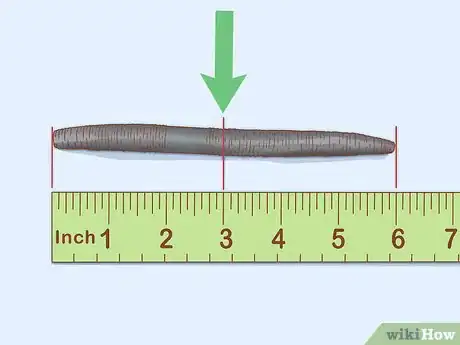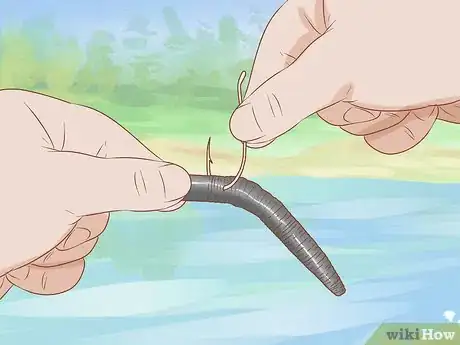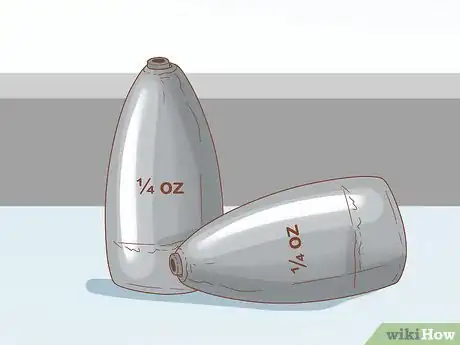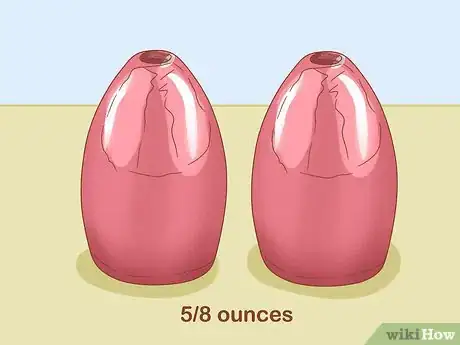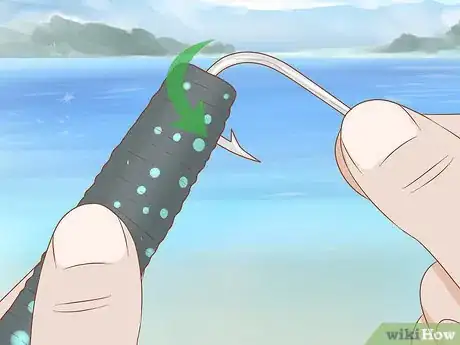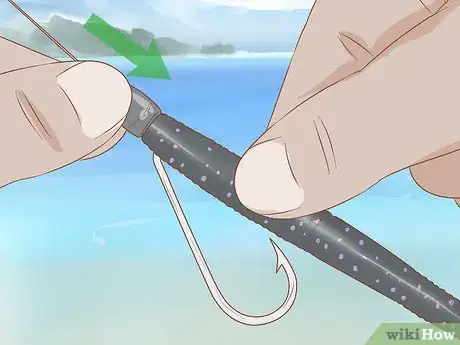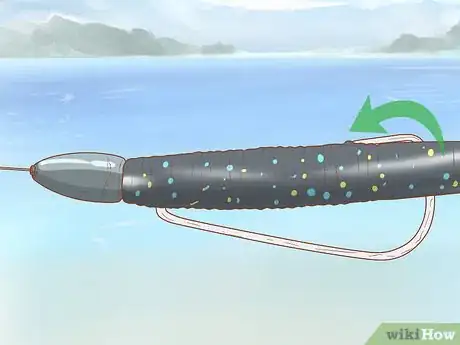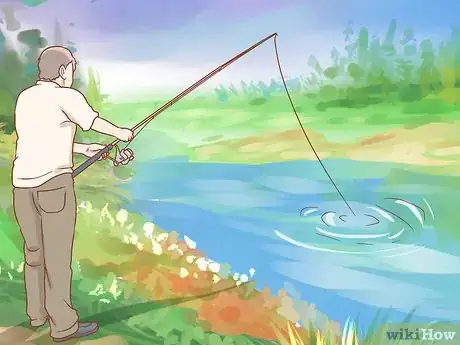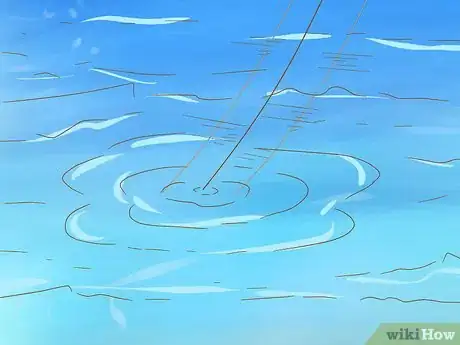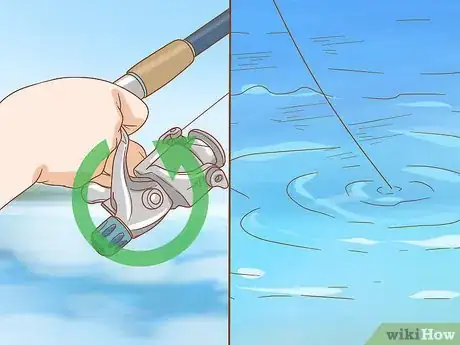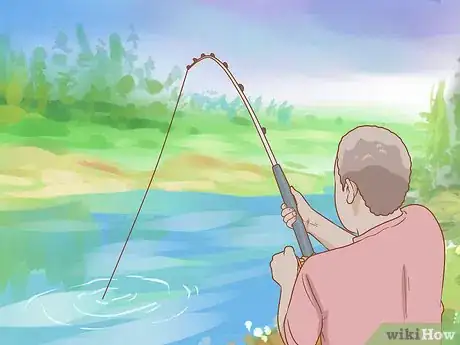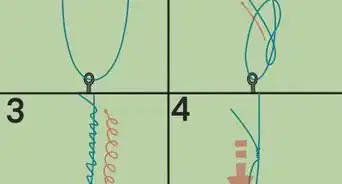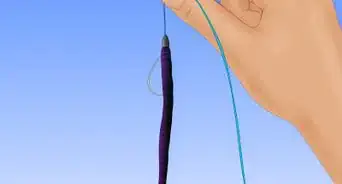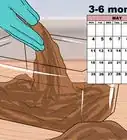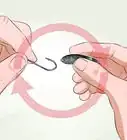This article was co-authored by wikiHow Staff. Our trained team of editors and researchers validate articles for accuracy and comprehensiveness. wikiHow's Content Management Team carefully monitors the work from our editorial staff to ensure that each article is backed by trusted research and meets our high quality standards.
There are 7 references cited in this article, which can be found at the bottom of the page.
This article has been viewed 7,866 times.
Learn more...
A Senko is a plastic worm that is a popular lure for bass fishing. Senkos are designed to "belly-flop" horizontally into the water, which can be more effective than the nosedive of most other soft-plastic baits. As Senkos reach the water, they wiggle in a very similar way to a baitfish. Fishing with a Senko is all about making the most of the liveliness of the worm, which is what the bass love!
Things You’ll Need
- Senko worms
- Hooks
- Bullet sinkers
- Line
- Reel
- Rod
Steps
Choosing the Color and Size of the Senko
-
1Choose a 4 in (10 cm) Senko for beginners or crystal clear water. A 4 in (10 cm) Senko is the smallest size available. It works well for beginners as it is lighter and easier to cast than other Senko sizes.[1]
- 4 in (10 cm) Senkos are the most effective size to use in water that is so clear that it's almost transparent.
-
2Use a 6 in (15 cm) Senko for slightly cloudy water. This size of Senko provides the best visibility to bass when the water is slightly difficult to see through. A 6 in (15 cm) Senko also works well when the fish are staying within shallow cover.[2]
- A 5 in (13 cm) Senko is very similar to a 6 in (15 cm) Senko, and they are often used interchangeably.[3]
Advertisement -
3Pick a 7 in (18 cm) Senko for very cloudy water. When the water is highly off-colored, a larger target is more likely to catch bass. This size also works well if it is a particularly windy day and as a result the water is choppy.[4]
- A 7 in (18 cm) Senko also works well for deepwater docks when a weightless rig is being used, as this size is heavy enough to fall fast.
-
4Try a watermelon with black and gold flakes Senko in deep, dark water. This Senko color is popular around the United States for its bass productivity. With deeper waters, it appears like a bluegill fish.[5]
- While this color works especially well in deep and dark water, in shallow water it can also be effective, as it will look like a gold shiner or young bass.
-
5Use a smoke with black, blue and gold flakes Senko in dense grass. This color is especially good for fishing from boat docks where the grass cover is very dense, and the bass are in the shallow waters. The gold flakes appeal to the bass, as this Senko looks like a panfish or bluegill pattern.[6]
- Depending on the surrounding water, this Senko color can also look like a minnow.
-
6Choose a salt-and-pepper color for a reliable Senko. This is an all-round color which has proven to be successful in many bass environments worldwide. As other colors have become more popular, salt-and-pepper has been used less frequently, but is still a color that proves to be consistent in productivity.[7]
Rigging a Weightless Texas Senko
-
1Choose the weightless Texas rig for clear to lightly cloudy water. This weightless rig is commonly described as the most effective way to fish Senko, because it optimizes the horizontal fall. Cast the Senko on a slack, controlled line, and let it sink freely to the bottom.[8]
- Using a weightless Texas rig in muddy water isn’t effective. Try out a weighted Senko instead.
- The weightless method is usually the most effective from late winter to the post spawn season. This is because the fish are generally more sluggish during this time, and will be attracted to this quieter, more subtle lure.[9]
-
2Push the hook through the center of the thick end of the Senko. The best type of hook to use for a weightless Texas rig is an offset shank worm hook. Push it through 1/2 in (1.3 cm) from the thick end for the best rig.
- A 3/0 hook size is recommended for this rig.[10]
- Although a variety of different hook sizes can be used for this rig, remember that using a bigger hook doesn't mean that you are more likely to hook a fish. This can disrupt the action of the Senko, making it less effective.
-
3Pull the hook gradually through the hole. Slide the hook through until you reach the end. This is where the eyelet and knot are.
- Stop pulling at this point, so that the eyelet and knot at the end of the hook remain hidden inside.
-
4Push the hook point through the Senko. Make sure that the Senko worm and the hook point alignment are parallel, with the curve of the hook being within the worm. The hook point will be very close to the body of the Senko.
- Hold the Senko straight while you are stabbing the hook through so that it will all align properly.
- The Senko shouldn’t be curved when the hook point is through, as being straight will help it to move naturally in the water.
-
5Tuck the hook point into the body of the Senko. Give the hook point a firm push into the centre of the worm. This will ensure that the Senko moves naturally and steadily in the water.
- Tucking in the point will also ensure that the Senko moves properly in dense coverage, such as within weeds, grasses, or moss.
Forming a Wacky-Style Rig
-
1Try a wacky-style rig when fishing in shallow, clear water. This tactic is still weightless, but instead has a live bait hook fixed at the midsection of the Senko. The live bait hook allows both parts of the Senko to freely flutter and dance.[11]
- The wacky-style rig can also be used in light grass and rocky banks.
-
2Determine where the center of the Senko worm is. Use a ruler or a tape measure to find out where exactly halfway between the two ends of the Senko is. This is where the hook will go.
- Placing the hook in the center of the Senko will let both ends move freely, which is key for a Wacky-Style Rig.
-
3Push the hook point through the midsection. Make sure that the hook goes through the very center of the worm. This will make sure that the rig works properly.
- Ensure that the hook point is pushed through the Senko so that the point is at a right angle to the worm.
Creating a Weighted Texas Rig
-
1Pick a lightweight rig for bluff walls, channel bends, and breaklines. A weighted Senko will sink much faster than a regular one, which means that it will attract the fish as a reaction bait. As a bass is swimming past, it will strike suddenly as it notices the weighted Senko, without stopping to look at it properly [12]
- A lightweight rig is also useful for areas away from shoreline cover with a depth of 10–20 feet (3–6 m) (3-6 m).
- Weights vary based on personal preference, but most light bullet sinkers are around ¼ ounce (7 g).
-
2Use a heavyweight rig when fishing with shallow shoreline cover. The heavyweight rig works best when fishing in dense grass or flooded bushes, as the added weight helps the Senko to “swim” down through the cover. Although the added weight can reduce the horizontal sink of the Senko, it does allow the Senko to reach bass that it otherwise wouldn’t be able to.[13]
- Most heavier bullet sinkers are around ⅝ ounces (18 g).
-
3Push the hook into the Senko ¼ in (0.6 cm) from the head. Make sure that the hook is far enough in that both the eyelet and knot are hidden within the Senko. You can move the hook by moving the Senko itself towards the offset area of the hook.
- A 4/0 or 5/0 straight shank hook is ideal for this rig.[14]
-
4Slide the bullet weight onto the nose of the Senko. The weight is concave shaped, and the worm will fit well into it. The smooth transition between the Senko and the weight will make the lure look more natural.
- Make sure that you thread your line through the bullet weight before tying it onto the hook.
-
5Push the hook point through the Senko body. Make sure that the worm is aligned and straight, and pierce the hook through the Senko. The hook point should be parallel with the Senko worm once it is pushed through properly.
Fishing with the Senko
-
1Cast the Senko with a slack line. Cast the Senko into the water, and wait for it to sink. A tight line will disrupt its horizontal fall.[15]
- The line tension for fishing with Senkos is a balancing act between having the line slack to let the Senko sink freely, and slightly controlled so that you can set the hook when the bass bites.
-
2Watch the line for signs of movement as the Senko sinks. As the Senko hits the water and starts to sink, the line will rest on the surface of the water, before eventually sinking with the Senko. If the lines changes from this pattern, or moves unnaturally, it is likely that a bass has bitten the Senko, so set the hook![16]
- You will be able to recognise the regular sinking pattern with enough practice, and will know what it looks like if a bass bites before it reaches the ground.
-
3Leave the Senko at the bottom if it hasn't already been taken. Carefully reel in the slack on the line, and let the Senko rest at the bottom for 10 seconds. This is when most of the bass strikes will occur.[17]
- Be sure to pay attention to the line at all times, as often you won't feel the bite but rather will see the line move.
-
4Set the hook when the bass strikes. Reel in the slack line until it's tense, and make sure that the rod is pointing directly to the fish. Then use your forearms to snap the rod over your shoulder quickly, and reel the bass in.[18]
- If the line is particularly difficult or heavy to reel back in, take a step back to get more leverage.
-
5Start retrieving the bait after 10 seconds. Quickly pull the tip of your rod upwards twice, before letting the Senko sink to the bottom naturally again. Gently reel in the slack line, and repeat this process until the Senko reaches you.[19]
- Bass will sometimes still bite on the retrieval process if they haven't already, but most of the time will bite while the Senko is sinking or once it has reached the bottom.
Warnings
- Make sure that you have a fishing license if necessary, and that you meet the fishing regulations for your region.⧼thumbs_response⧽
References
- ↑ https://www.bassmaster.com/tips/gary-yamamoto-senko
- ↑ http://www.bassdozer.com/articles/senko-gary.shtml
- ↑ https://www.bassresource.com/fishing_lures/senko.html
- ↑ http://www.bassdozer.com/articles/senko-gary.shtml
- ↑ http://www.bassdozer.com/articles/senko-gary.shtml
- ↑ http://www.bassdozer.com/articles/senko-gary.shtml
- ↑ https://www.bassmaster.com/tips/gary-yamamoto-senko
- ↑ https://www.fieldandstream.com/articles/fishing/bass/how-fish/2004/01/four-senko-tactics-largemouth-and-smallmouth-bass
- ↑ https://sdfish.com/articles/freshwater-articles/fishing-the-senko-in-san-diego/
- ↑ https://www.bassmaster.com/tips/gary-yamamoto-senko
- ↑ https://www.fieldandstream.com/articles/fishing/bass/how-fish/2004/01/four-senko-tactics-largemouth-and-smallmouth-bass
- ↑ http://www.bassdozer.com/articles/senko-gary.shtml
- ↑ https://www.fieldandstream.com/articles/fishing/bass/how-fish/2004/01/four-senko-tactics-largemouth-and-smallmouth-bass
- ↑ http://www.bassdozer.com/articles/senko-gary.shtml
- ↑ https://www.fishingskillz.com/senko-worms/
- ↑ https://www.fishingskillz.com/senko-worms/
- ↑ https://www.fishingskillz.com/senko-worms/
- ↑ https://1source.basspro.com/index.php/component/k2/237-fishing-info/859-the-fishing-basics-you-need-to-know-to-set-a-hook
- ↑ https://www.fishingskillz.com/senko-worms/
- ↑ https://sdfish.com/articles/freshwater-articles/fishing-the-senko-in-san-diego/
